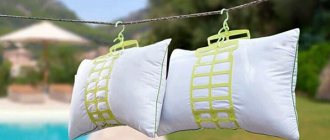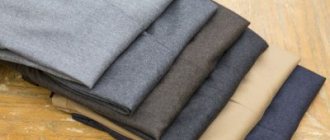Neoprene is a material based on synthetic rubber, which, due to its unique properties, has a wide range of applications. Items made from this fabric are easy to care for, safe and comfortable to use. They can be worn for a long time without fear of allergic reactions to the skin. Neoprene has an elastic and dense structure, so it allows you to fix the correct body position. Other benefits include its water resistance.
This is a strong and durable fabric that does not wrinkle, retains heat, and does not lose shape when worn for a long time. Things made of neoprene can withstand temperature changes, frost and direct sunlight well. Therefore, the material is used for the manufacture of:
- sportswear and clothing for everyday wear;
- orthopedic products;
- protective covers (for laptops, various gadgets, industrial equipment, medical devices, etc.);
- waterproof outerwear;
- diving and wetsuits.
Features of neoprene products
Neoprene is a very durable and excellent heat-retaining fabric.
The proposed type of material involves a unique foam fabric that has an interesting porous structure; it is synthetic rubber.
The front part of neoprene products (socks, trousers, top, gloves, tracksuit) is covered with a special polymer. The back is quite pleasant to the body, as it is lined with viscose, cotton, and polyester.
The fabric is actively used in the following areas: sports, medicine, industry, and the manufacture of consumer goods.
The washing procedure and specific care system are related to the area in which they are used. Neoprene is mainly used to make stylish and comfortable outerwear (cardigans, coats), skirts and shorts, as well as diving suits.
It’s easy to wash the products, you should remember that this is a durable and very durable fabric that retains heat, provides comfortable wearing and does not even wrinkle.
There is increased resistance to the influence of sunlight, moisture, temperature changes, and frost. The material is considered environmentally friendly and does not provoke allergic reactions.
Application of material
- For lovers of underwater adventures, wetsuits made from this rubber (type HS) are incredibly durable and keep a person warm.
- In the automotive industry - tubes, hoses, rings. Products made from this material (type HHS) reduce vibration and noise. And car seat covers have the longest service life. The construction industry produces roofing materials, sheaths for various cables, etc.
- In the medical field (W type): bandages, overalls, various shoes, etc.
- For sports and tourism enthusiasts (HS type), they produce coverings for sports equipment, clothing and camping equipment (waterproof tents, clothing, etc.).
- Firefighters and emergency workers wear rubber clothing (fireproof NF type) - this is protective clothing.
- Used for consumer goods: durable cases for carrying tablets (laptops, phones), shoes, beach flip-flops. Protects equipment and shoes from water and is resistant to sunlight.
- Since 2009, for the first time, N. Ghesquière, a fashion designer, presents an unusual collection of neoprene. These clothes, fashionable shoes, and various accessories have completely transformed the concept of fashion.
Rules for washing neoprene products
The proposed synthetic material is not capable of breathing or allowing air to pass through. It is not recommended to wear it in hot weather for more than three hours at a time.
The fabric is not able to deform or wrinkle, but it reacts violently with some substances:
- bleaches;
- alkalis;
- acids;
- oils;
- solvents.
ARTICLE FOR YOU
How to wash things from ranfors: in a washing machine and by hand
For this reason, the structure is destroyed. During washing, it is strictly forbidden to bleach or remove stains with aggressive detergents.
To keep colored items in good condition, you must follow the rules and care tips.
It is strictly prohibited:
- frequent washing;
- dry in a machine, on heaters, radiators;
- use bleaching products;
- use hot water for washing;
- twist, wring out;
- steam;
- iron.
Before performing any of the listed manipulations, you need to check and study the label. It contains all the important information regarding care rules.
Should neoprene be ironed?
After washing, there is no need to iron neoprene, since if properly dried, the material will return to its previous shape on its own. The main thing is not to wring out the products and dry them in a horizontal position. Things should be stored in an upright position on soft hangers. If necessary, you can put a special cover for clothes on top.
Proper care of neoprene includes gentle hand washing, horizontal drying naturally, the use of gentle detergents and no ironing or steaming. Do not wash items too often, do it only when necessary. Then neoprene items will last a long time, retain their color and presentable appearance for a long time.
Hand wash - time and temperature
Hand wash neoprene items
- Neoprene coats and dresses can only be washed by hand. Slightly warm water, the temperature of which is about 40 degrees, is suitable.
- It is allowed to use special liquid shampoo, soap solution, and neutral products that do not contain bleaches or chlorine.
- Pour water into the container, it is advisable to fill the bath, put things in for twenty minutes. An excellent advantage of the material is that it does not shrink.
- Wash the products on both sides, this is due to the fact that the material is waterproof. First, clean the outside, turn it inside out, and perform the necessary manipulations.
- Rinse well with cold water, leave in the bathroom for twenty minutes, excess liquid will drain.
- Drying is allowed horizontally; there should be no heaters or radiators nearby.
- Place things on a flat surface without bumps, straighten them, try to get rid of stripes and folds. Leave until completely dry, it is advisable to periodically pull back the edge.
What to consider when washing?
When washing neoprene items, it is necessary to take into account a number of properties of this material:
- neoprene is waterproof and moisture-resistant, so things made from it perfectly protect against moisture, however, due to this property, it will be necessary to clean the item on both sides alternately;
- it is resistant to damage and dirt, able to repel dirt particles, so neoprene items do not require frequent washing;
- clothes made from this material do not wrinkle, which also makes it easier to care for such things;
- neoprene holds its shape well and is elastic;
- the material is resistant to temperature changes (from -50⁰С to +90⁰С), as a result of which it does not wear out for a long time;
- neoprene retains heat perfectly without letting it out, therefore things made from this material are always warm, on the other hand, it is not breathable, so it is not recommended to walk in them for a long time;
- the material is hypoallergenic and environmentally friendly;
- Bacteria and pathogenic microorganisms cannot multiply on it, therefore neoprene is considered a safe material.
How to choose a clothes dryer for your home
As a result of these properties, neoprene clothing is worn for a long time and is characterized by a high degree of wear resistance. However, it is advisable to wash neoprene items only when there is really a need for it.
Washing in a washing machine - mode, temperature and time
Items of a dense type can only be washed by hand; it is not permissible to use a machine for them.
This rule applies to large and specific items that I cannot fit into the drum of the machine.
For everyday items (socks, skirts, shorts, etc.), you can use a washing machine. First, you should study the label and read the care instructions.
Recommendations:
- select delicate mode;
- time within 50 – 60 minutes;
- It is better to use cold water, temperature no more than 30 degrees;
- do not use powder, give preference to a special detergent, baby gel;
- disable "spin".
ARTICLE FOR YOU
How to properly wash knitwear
How to wash so that the material does not shrink
Hand washing will help preserve the original appearance and properties of the product for many seasons. To do this, it is advisable to use slightly warm water; the temperature should not exceed 30 - 40 degrees Celsius.
- Use gel or soap as a detergent that does not contain stain removers or bleaches.
- The main advantage of neoprene products is that they do not shrink. In order not to take unnecessary risks, it is better not to neglect the rules.
- Soak the item in water for twenty to thirty minutes, first the front side, then turn it inside out, leave for ten minutes.
- Drain and rinse.
- Do not twist or squeeze, otherwise there is a huge risk of damage to the structure itself.
- When the contamination is not very serious, it is worth cleaning without detergents.
How to wash so that the fabric shrinks
Neoprene is a unique synthetic material that has a number of properties and advantages.
One of the main advantages is the unique ability not to wrinkle or sit down under any conditions.
If washed incorrectly, there is a risk of damage to the structure and the appearance of tears.
In addition to the fact that neoprene does not shrink, it has many more positive qualities: heat capacity, elasticity, lightness, ductility, wear resistance, durability, water resistance. Disadvantages include: the need for special, specific care, does not breathe.
Tips and methods for ironing dermantine
Dermantin, or artificial leather, is very sensitive; folds and creases often form on it. The fabric is made from a nitrocellulose coating applied to cotton fabric or a knitted base. Products made from dermantine wrinkle extremely badly when folded for a long time. However, you can fix the defect yourself in one of three ways:
- Ironing.
- Vertical steaming;
- Without using an iron.
Ironing method
The fastest, but unsafe way to smooth a dermantine product is regular ironing using an iron heated to thirty (maximum forty) degrees. How to iron dermantine correctly?
- Be sure to turn it inside out.
- With quick movements, without stopping for a second on the surface, iron out the resulting creases.
Tip: you can use a thick roller made of a towel, placing it under the product and constantly rolling it while ironing.
Vertical steaming method
If there is a danger of damaging the dermantine, you can use the hot steaming method:
- Hang the item on hangers.
- Turn on the vertical steam function on the iron.
- Try treating a small piece of skin.
- Steam all folds and leave the product on hangers until completely dry.
Method without iron
Rarely, but there are situations when there is no ironing device at hand. How to smooth out dermantine in this case? Simply moisten the inside of the product with clean water from a spray bottle, hang it on a hanger, and straighten out any creases with your hands if possible. After a day, when the skin is completely dry, the folds will disappear.
And to ensure that jams are removed, you need to send the product to a “steam room”. Fill the bath with hot water, place hangers with a dermantine item over the surface and leave, for example, overnight.
To stroke natural leather, you need to put in a lot of effort and ingenuity, because such material needs to be treated with care. But our article will tell you about all the secrets and nuances of ironing that will help remove even severe creases.
Leatherette also needs delicate handling, unless, of course, you want to ruin your favorite jacket or skirt. The most popular methods of ironing leatherette are described here.
Detergents
The fabric can be washed using products that do not contain chlorine.
Recently, foam rubber is often used in sewing trendy items.
This is not at all surprising, since the fabric does not shrink, does not wrinkle, retains its shape elegantly, and has dirt-repellent and powerful waterproof properties.
The material requires special care; many people prefer dry cleaning. If washing is carried out at home, it is advisable to use neutral products that do not contain chlorine.
Basically, baby gel, regular soap, or a solution based on it are suitable. It is recommended to use a specialized shampoo designed for cleaning wetsuits.
ARTICLE FOR YOU
How to properly wash staple clothes and linen: in a washing machine and by hand
Bleaching Neoprene Fabric
Neoprene is a special type of rubber that is covered with fabric, most often cotton and viscose are used. This is a modern, fashionable, comfortable, practical, high-tech material.
The product will retain its unique properties and will last for many years if you care for it properly.
For such purposes, it is strictly prohibited to remove stains, bleach, wring out, twist, or use chlorine-containing products.
Drying
Neoprene products may only be dried horizontally. Preferably outdoors, but possible in a ventilated area.
It is prohibited to use additional heat sources - heaters, hot air - in the process. It is important to ensure that the product is not exposed to direct sunlight.
Thanks to the horizontal position, all moisture drains away and ensures complete, uniform drying, including stitches and seams.
The use of heaters and exposure to heat disrupts the amazing properties of matter.
Rules for ironing nylon products
Nylon products are very fancy, but can be processed with a heated iron. Ironing rules are similar to recommendations for ironing stretch fabrics, although there is a significant nuance. How to iron nylon? Only through thick natural, always dry fabric. This is the main requirement. For example, a piece of pure chintz will do.
Instructions:
- Place the product on the ironing board.
- Set to delicate mode. If there is no “hint”, set the temperature yourself: 100-110 degrees.
- Turn off the steamer! Moisture along with high temperature will have a detrimental effect on the nylon product.
- Cover the product with a thick cloth.
- Carefully move the surface of the iron over the product. You can make light ironing movements without stretching the fabric.
Important! When exposed to steam, nylon fabric is deformed.
Selection, operation and care of a neoprene wetsuit
Sources:
- ya-podvodnik.ru
- www.alexdiver.ru
We'll talk about neoprene. Let's start with the mistakes that people make when using neoprene and which have a bad effect on the final quality, long-term wear and operation of the suit. Then we’ll go through all the stages of maintaining a new, clean suit.
Firstly, the suit should always be dried in the shade after diving. There is no need to dry it in the sun, as rubber is afraid of ultraviolet radiation. It should be dried in the shade in the breeze and always on both sides. If the outside of the suit dries quickly, then from the inside it takes quite a long time to dry. The suit must be dry. Even if you dive every day, don’t be too lazy to hang it on hangers, let it hang and dangle. To prevent the suit from becoming wrinkled, hang your pants as usual, and hang your jacket by the tail and upside down. In this case, it hangs comfortably and wrinkles minimally. The suit must be clean; neoprene is not afraid of washing. You can wash with any powder, but preferably without bleach, such as Ariel. It is better to use powder for colored laundry so that the suit does not discolor.
If we touched on washing, what mode should the washing machine have and what next?
Usually the suit is washed by hand in a basin in warm water 30-40 degrees.
What about in the car?
Load the suit into the machine and set it to the most gentle “wool” mode.
What is the maximum temperature?
40 degrees, but better than 30 degrees, and even better, wash in cold water.
Is washing in a washing machine generally recommended or not?
You can wash it, nothing happens. The most important thing is not to spin the suit in the washing machine and not to dry it there.
Many people think that the edges of a suit may begin to fray if it has been in the washing machine.
If you set the gentle “wool” or “underwear” mode, it’s not scary. There is no need to rinse in the machine or use the “spin” mode, which leads to shaggy hair, because... Neoprene has a delicate coating.
Now let's touch on drying. We have already found out about the sun. And now the question is: can you dry it on heating devices?
No need, it’s better to hang it in the shade and let it dry there. Rigorous tests were carried out in dolphinariums, where the suits are used 2-3 times a day. The suits are hung on hangers, they have fan heaters in the dryer, and the temperature is maintained at about 30 degrees. In such conditions, the suits can withstand 1.5 thousand cycles, and everything is fine, the suit lives. These are real facts.
Okay, next question. When a person maintains his own suit, it’s understandable. And if the suit is stored folded for quite a long time, what changes occur to it?
The suit wrinkles in interesting places: arms, neck, belt, groin. It just crumples. First of all, he loses his appearance, i.e. actual presentation, thickness varies
Doesn't it melt back?
It doesn't go back. Rubber has the ability to compress.
People often see suits in stores that have been stored incorrectly, either due to the store's fault, or were packaged incorrectly by the supplier. They are wrinkled. How critically should you look at this? Should the suit be completely wrinkle-free and absolutely smooth, without kinks or pinches? Often in stores they say: “Don’t worry. You will swim and everything will be fine.”
In principle, everything will really be fine, but the suit will lose its presentation. Somewhere he got squeezed, but that won’t change.
Very often people are faced with the need to store a suit for a long time. The season passed, people sailed away, put them in a bag and put them on the mezzanine. How to properly store a suit in winter if it does not hang on a hanger, but lies folded somewhere?
The only correct way to store a suit is on a hanger. Everything else is wrong.
What if it's in a bag?
It is not right.
Many people use talcum powder. Do I need to top it up and with what?
There is no need to add talcum powder. You just need to hang the suit, put it in a plastic bag, like a fur coat, and hang it up.
Many people who store their suit incorrectly take it out after winter and find it stuck together. People begin to unstick and tear off pieces of neoprene directly. How to behave correctly in such a situation?
It is better to put the suit in water and soak it. In fact, before winter it should be thoroughly rinsed from the inside, otherwise the shampoo remains and dries out, which leads to the suit sticking together. If this happens, then you need to soak it. Soak for a long time: let it sit for a day, for two or three, so that it all somehow disperses.
Let's talk about the factors that destroy neoprene. The factors are not of a mechanical nature, but about chemicals or bacteria that settle on the suit and lead to the destruction of neoprene. What shortens its service life, what are neoprene’s enemies among biochemical things?
The recommendations are very simple. If the suit is washed with fresh water after use, then it is washed of all natural secretions, so that there is no smell and what is not needed is not absorbed, so that smelly and nasty bacteria do not settle.
Where do the bacteria that lead to the destruction of the suit come from?
In a dolphinarium, for example, fish decompose, bacteria appear, settle on the suit and eat up pieces of neoprene. Often, especially at sea, it is clear that people who have been using a suit for a long time begin to crack and collapse right at the top. These are other factors, these are salt and sun. What is the situation? In bright sunny weather people swim. The back, naturally, is on the surface, and on the suit there are droplets of water in which the sun is focused, like in lenses, and directly burns everything. Neoprene begins to age rapidly. Heating occurs pointwise. This is a factor that cannot be avoided. The suit ages and wears out like jeans.
There are many folk ways to get rid of unpleasant odor. Some people suggest diluting apple cider vinegar. Special fragrances have appeared in stores, supplied by costume manufacturers, so that the fragrance takes away the smell. How to get rid of an unpleasant odor?
You can use regular powder. There are special disposable products that cost about 50-70 rubles. In terms of price, when compared to a tube of regular shampoo, they are expensive, but they are specially made to fit neoprene.
Have you tried using them?
Me not. There are all sorts of aerosol sprays to eliminate odors. This is advanced American and European chemistry.
What substances would you recommend swimmers use when putting on a suit that are suitable not only for neoprene, but also for skin?
Each of us is individual. Nowadays there are many allergy sufferers, as civilization is advancing. You need to understand that not all skin can withstand cheap shampoo or Ferry. People still manage to use bubble bath or even Pemolux. In addition to the fact that they contain soda and therefore harm neoprene, they also irritate the skin.
We recently translated a Spanish article, which states that it is healthier for the body to use natural olive oils, although it is then difficult to wash off the oil yourself and wash your suit. The Spaniards believe that all shampoos are carcinogenic and are not intended to remain on the skin for a long time. It's probably better to use baby soap.
15 years ago I always had baby soap in my kit. I washed myself, rather than soaping the suit, and everything worked out fine. Last year I forgot my shampoo in Novorossiysk. I went swimming, but there was no shampoo. I put on the suit just like that, I didn’t even expect it. I thought I would be stuck with the jacket. He scooped up some water and calmly put it on. Of course, I didn’t deal with it so well and comfortably. But in warm weather you can dress without shampoo. My suit, by the way, was smaller than my size and fit tightly.
Care of a neoprene wetsuit
We wash, iron and clean our everyday clothes. We try to take care of it, and we get very upset when our favorite thing becomes unusable. Our wetsuits also require attention, because they are no less important to us divers than ordinary clothing. We’ll look at some tips on how to extend the life of your wet hydra and preserve it in this article.
What is a neoprene suit, and the neoprene material itself?
Neoprene is a type of synthetic rubber. Originally a proprietary trademark of DuPont. Soft, porous, waterproof, elastic material. Usually black (wetsuits get their color from the top layers of colored material, such as nylon). It has many applications: from wetsuits to the housing module of the international space station.
In scuba diving, neoprene is used in various forms. For wetsuits, ordinary or porous neoprene is used. For the manufacture of dry suits, compressed neoprene (or neoprene whose pores are partially or completely crushed) is most often used, this increases the reliability and reduces the buoyancy of the wetsuit. For underwater hunting, ordinary neoprene is used, but with a cut off pore (open pore), due to which the material sticks to the body like “suction cups” and the circulation of water under the suit is reduced, and the underwater hunter becomes warmer. Different types of wetsuits (and therefore neoprene) have their own purposes and are suitable for certain types of activities. For example, neoprene suits for surfers are similar to diving suits, but are not designed to withstand water pressure, and as a result will quickly become unusable if we dive into them.
Wetsuit size.
A wetsuit should fit snugly. We know this from our very first diving course. Then the amount of water penetrating under the suit will be minimal. But don't get carried away! A suit of a small size may tear or simply stretch, which will reduce the thickness of the suit (for example, your five will turn into three) and its heat-protective properties. A suit that is too large will constantly leak cold water and you will freeze faster.
Washing a wetsuit.
After each dive, the suit must be desalinated (rinsed in clean water). It is advisable to do this after the pool, because chlorine also negatively affects the material of the suit. But in addition to standard desalination, the suit needs to be washed from time to time. You can wash it in a washing machine, but be sure to use a gentle cycle and without spinning, otherwise you will ruin the neoprene. The easiest way to wash is to soak the suit in the bathroom for a day or more in warm water. Do not use washing powders with bleach or any solvents. These chemicals can destroy the material of the suit. Dive shops sell special shampoos for wetsuits - they can be used safely. Using shampoo, you will clean your suit of salt and other contaminants. I know that some divers use just ordinary shampoos for washing, the main thing is to rinse the hydrach well to remove any remaining shampoo.
Drying the suit.
You can dry your neoprene wetsuit like regular clothes (outdoors or indoors). You should not leave it under the scorching sun or near sources of strong heat (heating appliances, etc.) - high temperature can destroy the structure of neoprene. In the shade and in the breeze, your suit will dry comfortably and quickly. Remember to dry the inside of the suit thoroughly before storing it.
Storage and transportation.
It is best to store a wetsuit by hanging it on special (wide and soft) hangers. It is not recommended to fold neoprene - the creases that form as a result of this may no longer straighten out.
When transporting a suit in a stuffed, heavy diving bag, it is best to roll it into a tube (while being careful not to form creases). Make sure that there are no heavy objects on top of the suit. Do not wrinkle or crumple it, otherwise you will wrinkle the neoprene and it will not straighten out.
Breakdowns.
Very often our favorite costume suffers due to our carelessness. We can get caught on something in the water, on a ship or on the shore and tear our pet. I observed a situation where wetsuits were torn while being pressed into the water from the zodiac, having caught on the handle located on the side. Always look at where you sit, so that there are no objects that you can get caught on. The threads sticking out of the seams can be burned with a lighter, and a drop of silicone glue can be applied to prevent the seam from spreading further. Stretch the cuffs on your arms and legs carefully so as not to tear them. You can use regular clear plastic bags when putting them on, this will make it easier to slip into the sleeves or legs and the cuffs will remain intact. Feel free to ask your partner for help when zipping up the back. Of course, there is a very convenient nylon cord, but it is designed for easy unfastening, and not vice versa. If you pull this cord with force, the neoprene near the zipper may tear. Moreover, this gap will be at the very bottom of the zipper, and a hole (and subsequently a patch) at the fifth point will not give you attractiveness and charm in the eyes of fellow travelers.
I hope this article will help you keep your wetsuit in excellent condition for as long as possible!
Comments ()
www.turist-club.ru
What do you make from Scuba?
Dresses, blouses, and suits are made from it. Material composition: polyester (90%) with lycra (10%). Scuba jersey is not deformed. Products made from it are comfortable to wear, since this fabric does not restrict movement.
Interesting materials:
What can be said about distance learning? What can be said about the Earth's magnetic field? What can be said about inanimate nature? What can you say before going to bed to make your betrothed dream? What can you say to a friend on her birthday? What can you say about the cactus? What can you say about handwriting? What can you say about the elephant? What can you Craft from Weeping Obsidian? What can you craft from coal in Minecraft?











